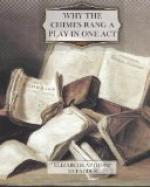The pieces by Ropartz and Gevaert were chosen for the Workshop production by Dr. A.T. Davison, organist at Appleton Chapel, Harvard University, and are admirably fitted to the play. Mr. Atherton’s Alleluia is also just what is needed, both in length and in the triumphant crescendo which carries the piece fittingly and dramatically to its close. It would be difficult to replace this finale except by other music written for the purpose.
The music is perhaps the most important single element in the play. In the original version the scene in the chancel was carried by dialogue but production showed the mistake. From the time that the music begins, it, with the pantomimic action of the actors is all sufficient to interpret the mood and meaning of the scene.
A small parlor organ is practically a necessity and can probably be procured for the cost of the cartage.
A choir of men’s and women’s voices is best for the singing but a good quartette will serve.
For the bells, the long tubular chimes which are suspended by one end and struck with a wooden hammer are the most satisfactory. If they seem too metallic, try covering the head of the hammer with folds of chamois skin. If such a set of chimes is not to be had a substitute can be found in the phonograph, for which there are a number of chimes records.—The tune played on the phonograph must not be a modern one; Luther’s Hymn “Great God, what do I see and hear?” (A Columbia record) is the best. The tune can be disguised by lifting the needle occasionally and setting it down gently on another part of the record. As far as I know, no phonograph record presents chimes pure and simple. It should be remembered however that the phonograph record lacks the vitality of tone and the note of jubilant triumph which a good musician can bring from the bells themselves.
With the exception of the crescendo at the end of the Alleluia, the music is kept soft and dreamy throughout. It is a temptation to try to achieve this effect by placing singers and organ back, off stage, so that the sound may come from a distance but it has been found that the whole performance gains immeasurably if the organist is in front where he can watch every movement of the actors and interpret them in his playing.
The music begins on Holger’s speech: “Oh thou art warm” and continues in one form or another throughout the play.—The organist commences in the middle of the Ropartz “Sortie,” at the top of page 6 and continues this until the back of the hut is withdrawn when he drifts into the accompaniment of the Gevaert song, and plays it through once without the voices. As Holger cries “Dame!”—and sinks back against the woman’s knee, this verse should end, and the voices of the choir take up the song with the organ.
From this point on every movement in the chancel is paced to the rhythm of the music. It has been found that a verse of the Gevaert song is just long enough to fit the following action.




